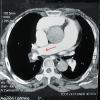Successful Treatment of Acute Bilateral Pulmonary Thromboembolism Using Accelerated Regimen of Thrombolytics: A Case Report
- PMID: 40786417
- PMCID: PMC12334950
- DOI: 10.7759/cureus.87600
Successful Treatment of Acute Bilateral Pulmonary Thromboembolism Using Accelerated Regimen of Thrombolytics: A Case Report
Abstract
Acute pulmonary thromboembolism represents a critical, life-threatening condition that necessitates immediate and effective management to minimize associated mortality. Although the current recommendation for managing hemodynamically unstable pulmonary embolism (PE) is the regimen of 100 mg recombinant tissue plasminogen activator (rtPA) administered over two hours, an accelerated regimen of rtPA (0.6 mg/kg over 15 minutes, maximum 50 mg) has also been described for the management of PE and circulatory arrest. We report the case of a 65-year-old female patient who presented with acute bilateral pulmonary thromboembolism at intermediate-high risk. She was treated with an accelerated rtPA regimen, following which she demonstrated significant clinical improvement. Her oxygen saturation improved from 88% to 96%, and her respiratory rate decreased from 36 to 20 breaths per minute. Hemodynamic parameters remained stable throughout treatment. A computed tomography pulmonary angiogram (CTPA) performed on day 4 showed marked resolution of thrombi and improved pulmonary perfusion. No major bleeding complications occurred, and the patient was safely transitioned to oral anticoagulation. This case underscores the potential noninferiority of the accelerated thrombolysis regimen compared to the conventional two-hour regimen in terms of mortality and pulmonary vascular resistance, with a tendency toward fewer bleeding complications observed with the accelerated regimen.
Keywords: accelerated regimen; acute pulmonary thromboembolism; pulmonary embolism severity index; recombinant tissue plasminogen activator; right ventricular dysfunction.
Copyright © 2025, Tharsiga et al.
Conflict of interest statement
Human subjects: Informed consent for treatment and open access publication was obtained or waived by all participants in this study. Conflicts of interest: In compliance with the ICMJE uniform disclosure form, all authors declare the following: Payment/services info: All authors have declared that no financial support was received from any organization for the submitted work. Financial relationships: All authors have declared that they have no financial relationships at present or within the previous three years with any organizations that might have an interest in the submitted work. Other relationships: All authors have declared that there are no other relationships or activities that could appear to have influenced the submitted work.
Figures




References
-
- Clinical outcomes of very elderly patients treated with ultrasound-assisted catheter-directed thrombolysis for pulmonary embolism: a systematic review. Castillo-Perez M, Jerjes-Sánchez C, Rodríguez D, Paredes-Vazquez JG, Panneflek J, Vazquez-Guajardo M. https://doi.org/10.1007/s11239-021-02409-3. J Thromb Thrombolysis. 2021;52:260–271. - PubMed
-
- Clinical outcomes of very elderly patients treated with ultrasound-assisted catheter-directed thrombolysis for pulmonary embolism: a systematic review. Castillo-Perez M, Jerjes-Sánchez C, Rodríguez D, Paredes-Vazquez JG, Panneflek J, Vazquez-Guajardo M. J Thromb Thrombolysis. 2021;52:260–271. - PubMed
-
- Fibrinolysis for patients with intermediate-risk pulmonary embolism. Meyer G, Vicaut E, Danays T, et al. https://doi.org/10.1056/nejmoa1302097. N Engl J Med. 2014;370:1402–1411. - PubMed
-
- Pulmonary embolism. Huisman MV, Barco S, Cannegieter SC, et al. https://doi.org/10.1038/nrdp.2018.28. Nat Rev Dis Primers. 2018;4:18028. - PubMed
Publication types
LinkOut - more resources
Full Text Sources
